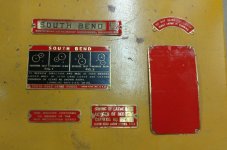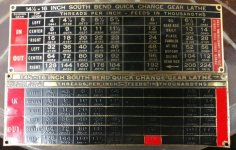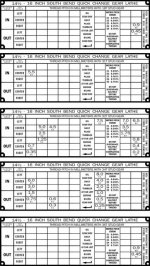thomasutley
Hot Rolled
- Joined
- Sep 10, 2014
- Location
- Oro Valley
I'm in the process of etching replacement brass nameplates and switch legends for my 1943 16" lathe. So far for parts like the War Board tag, the Catalog No./Swing tag, etc., I've gotten away using a condensed variant of Franklin Gothic using minor Inkscape manipulation to control kerning and word spacing. However, the gearbox threading chart seems to be a completely different animal, with unique typographic features especially in the S and Q characters, that does not fit well with the Franklin Gothic family.
The "Grotesk" font family is close, and Helvetica comes close in other respects, but neither is quite right for the S and Q which are so prominent on the top line of this plate.
Has anyone here had better results searching for a matching font on their own etched plates? Seems like SBL Co. would not have had a very wide field from which to choose in the 1940s for industrial labels, or am I assuming too much and it could be anything or even custom designed in-house?
I would love to understand the process they used for making etching masks back then.
Thanks,
Tom

The "Grotesk" font family is close, and Helvetica comes close in other respects, but neither is quite right for the S and Q which are so prominent on the top line of this plate.
Has anyone here had better results searching for a matching font on their own etched plates? Seems like SBL Co. would not have had a very wide field from which to choose in the 1940s for industrial labels, or am I assuming too much and it could be anything or even custom designed in-house?
I would love to understand the process they used for making etching masks back then.
Thanks,
Tom










